
About UsThe Numismatic Bibliomania Society is a non-profit organization devoted to the study and enjoyment of numismatic literature. For more information please see our web site at coinbooks.org SubscriptionsThose wishing to become new E-Sylum subscribers (or wishing to Unsubscribe) can go to the following web page link MembershipThere is a membership application available on the web site Membership Application To join, print the application and return it with your check to the address printed on the application. Membership is only $20 to addresses in the U.S., $25 for First Class mail, and $30 elsewhere. For those without web access, write to: David M. Sundman, Treasurer
AsylumFor Asylum mailing address changes and other membership questions, contact David at this email address: dsundman@LittletonCoin.com SubmissionsTo submit items for publication in The E-Sylum, just Reply to this message, or write to the Editor at this address: whomren@gmail.com BUY THE BOOK BEFORE THE COIN |
- WAYNE'S WORDS: THE E-SYLUM OCTOBER 19, 2014
- NBS WIKI WOODWARD SALE PAGE COMPLETED
- NEW BOOK: GUIDE BOOK OF CIVIL WAR TOKENS, 2ND EDITION
- NEW BOOK: THE COINS OF INDIA: THE MUGHAL EMPERORS
- NEW BOOK: OTTOMAN NUMISMATICS MANUAL FROM A TO Z
- REVIEWER SOUGHT FOR PLEASURE AND PROFIT
- THE 1796 MYDDLETON TOKEN
- A VISIT TO THE OLD SAN FRANCISCO MINT
- THE ROSE MACHINE AND OTHER GEOMETRIC LATHES
- NOTES FROM E-SYLUM READERS: OCTOBER 19, 2014
- VOCABULARY WORD: TYPOGRAPHIC
- VOCABULARY WORDS: COIN, TOKEN AND MEDAL SHAPES
- BOB EVANS REVEALS LATEST SS CENTRAL AMERICA DISCOVERIES
- 1715 FLEET SOCIETY TO EXHIBIT SUNKEN TREASURE
- BLOOM'S LAW OF THE PROFITABLE INERTIA OF GOLD
- SELECTED LOTS FROM KOLBE-FANNING SALE #137
- AN ODD 1793 WREATH CENT
- WAYNE'S NUMISMATIC DIARY: OCTOBER 19, 2014
- THE NUMISMATIST PROFILES ERIC SCHENA
- U.S. SEMIQUINCENTENNIAL CELEBRATION PLANNERS WANTED
- MICRONATION STATECRAFT FOR DUMMIES
- REVIEW: DAVID HENDIN LECTURE ON BIBLICAL COINS
- DIRTY MONEY RUMORS AND EBOLA
- MORE SELECTIONS FROM THE STACK'S BOWERS 2014 BALTIMORE SALE
- SELECTIONS FROM THE LYN KNIGHT PCDA 2014 SALE
- AUSTRALIAN ARTICLE HIGHLIGHTS BANKNOTE ERRORS
- ELEPHANT ON NEPAL 1,000-RUPEE NOTE QUESTIONED
- BANK OF CANADA WOMEN'S TROUBLE CONTINUES
- KERRY STOKES: AUSTRALIAN BUYER OF VICTORIA CROSS MEDALS
- MORE ON POP-UP COINS
- PAUL BOSCO RECALLS FAILED SLAB SALE ATTEMPT
- FEATURED WEB PAGE: MICRONATIONS
Click here to access the complete archive
To comment or submit articles, reply to whomren@gmail.com
WAYNE'S WORDS: THE E-SYLUM OCTOBER 19, 2014

I didn't manage to get everyone's input into the issue this week, but all the better to kickstart next week's issue. If you've sent me something and haven't heard back, hang in there and check with me midweek.
New subscribers this week include: Louis Brousseau. We now have 1,779 subscribers.
This week we open with a great milestone for our NBS Wiki, and three new numismatic books. Other topics include the 1796 Myddleton token, the Old San Francisco Mint, vocabulary words, geometric lathes, dirty money rumors, and pop-up coins.
To learn more about Woodward's Sale A, the Rose Machine, a coin pedigreed to Sir Arthur Conan Doyle, Balanoid, Ovoid and Oculiform coins, the 1715 Fleet Society, a Swedish Carnegie hero medal, and Micronation Statecraft For Dummies, read on. Have a great week, everyone!
Wayne Homren
Editor, The E-Sylum
NBS WIKI WOODWARD SALE PAGE COMPLETED
Tom Wetter writes:
 After quite some time and a lot of work, the NBS Wiki
page for W. E. Woodward auction sales is virtually complete. Every sale is now documented and there
are images of some items that have probably never been seen by a great many of us. An unrecorded
Addenda for Sale 91, plate envelopes for the Vicksburg sales, the ultra rare sales #1, #92 and Sale
A. Many of these are in remarkable condition.
After quite some time and a lot of work, the NBS Wiki
page for W. E. Woodward auction sales is virtually complete. Every sale is now documented and there
are images of some items that have probably never been seen by a great many of us. An unrecorded
Addenda for Sale 91, plate envelopes for the Vicksburg sales, the ultra rare sales #1, #92 and Sale
A. Many of these are in remarkable condition.
I would like to express my sincere gratitude to Michael Sullivan, Charlie Davis and David Hirt for their assistance and expertise, and also for all of the images that were provided.
To visit the Woodward Wiki page, see:
wiki.coinbooks.org/index.php/WILLIAM_ELLIOT_WOODWARD_AUCTION_SALES
NEW BOOK: GUIDE BOOK OF CIVIL WAR TOKENS, 2ND EDITION
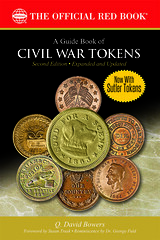 Whitman Publishing announces the release of an expanded,
updated second edition of the award-winning Guide Book of Civil War Tokens, by Q. David
Bowers. The 512-page book will debut in December 2014, and will be available online (including at
Whitman.com) and from bookstores and hobby shops nationwide. Its retail price is $39.95. It can
also be borrowed for free as a benefit of membership in the American Numismatic Association,
through the Dwight N. Manley Numismatic Library (money.org/library).
Whitman Publishing announces the release of an expanded,
updated second edition of the award-winning Guide Book of Civil War Tokens, by Q. David
Bowers. The 512-page book will debut in December 2014, and will be available online (including at
Whitman.com) and from bookstores and hobby shops nationwide. Its retail price is $39.95. It can
also be borrowed for free as a benefit of membership in the American Numismatic Association,
through the Dwight N. Manley Numismatic Library (money.org/library).
The first edition of the Guide Book of Civil War Tokens debuted in August 2013 at the American Numismatic Association World’s Fair of Money in Chicago. Bowers autographed copies at the Whitman Publishing booth and presented an overview at the meeting of the Civil War Token Society. The first edition was very popular, with its first print run selling out before year’s end. In 2014 it won the Token and Medal Society’s Mishler Exonumia Cataloguing Award.
The second edition is an update and expansion of the first, with 64 more pages. It features a completely new 50-page illustrated appendix on sutler tokens (private issues of government-licensed contractors who typically operated camp stores in connection with traveling military regiments); hundreds of individually updated values based on today’s market; new (and more) images; the latest research in this active field; and a bibliography of related books, journals, and Web sites.
Civil War tokens are small cent–sized tokens, mostly of copper or brass, that were issued by private firms to serve as emergency "money" during the small-change shortage of 1862 to 1865. As the military conflict dragged on, Americans hoarded any gold, silver, and eventually even copper U.S. coins they received in change, keeping them as hedges against wartime economic uncertainty. Civil War tokens, privately issued by hundreds of merchants and organizations and minted in the millions, were used as substitutes for hoarded "pennies" to make change for small purchases. Today these tokens are highly collectible, with values generally ranging from $15 for common, circulated pieces to more than $15,000 for rarities including unique tokens. In recent years, with eBay offerings, professional auction listings, and other opportunities to buy and sell, Civil War tokens have emerged as a dynamic part of the marketplace.
Bowers, widely regarded as the "Dean of American Numismatics," wrote A Guide Book of Civil War Tokens with the cooperation of the Civil War Token Society, the American Numismatic Society, the Token and Medal Society, the American Numismatic Association, and other leading organizations, museums, libraries, collectors, dealers, and researchers. The book includes more than 2,000 full-color images, plus values in multiple grades, rarity ratings, detailed historical background, a study of how Civil War tokens were manufactured, ways to collect them, identification of unusual varieties, and information on the potential for valuable new discoveries. It covers both patriotic tokens and "store cards" (merchant advertising tokens), as well as sutler tokens (some of which used Civil War token dies) and encased postage stamps of the era. Nearly every known Civil War token die is described in both pictures and text.
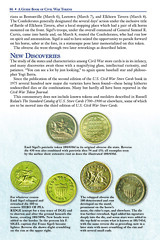
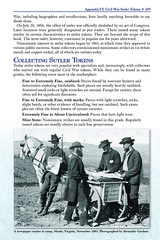
"There is no other reference like the Guide Book of Civil War Tokens," said Whitman publisher Dennis Tucker. "It is the only full-color illustrated price guide to these collectible pieces of Americana. With a small investment of $39.95—about the price of a common copper token in Extremely Fine condition—a collector, dealer, or appraiser can become an expert on Civil War tokens and sutler tokens."
"No book on how to collect Civil War tokens has ever been as thorough," said Dr. George Fuld, a well-known expert in the field. "I expect that it will be a standard reference for years to come." Fred Reed, another specialist in Civil War money and editor of the Token and Medal Society Journal, said, "Every collector of this series will esteem this volume, and every historian or serious writer on the Civil War should consult its colorful pages in the future."
Volume 16 in the Bowers Series
By Q. David Bowers · Foreword by Susan Trask · Reminiscence by Dr. George Fuld
ISBN 0794842941 · 512 pages · 6 x 9 inches, softcover · Full color · Retail $39.95
For more information, or to order, see:
A Guide Book of Civil War Tokens, Second Edition
(www.whitman.com/store/Inventory/Detail/A-Guide-Book-of-Civil-War-Tokens-Second-Edition-+0794842941)
THE BOOK BAZARRE
NEW BOOK: THE COINS OF INDIA: THE MUGHAL EMPERORS
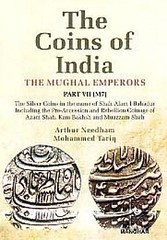 Authors (s): Arthur Needham (Author) , Mohammed Tariq (Author)
Authors (s): Arthur Needham (Author) , Mohammed Tariq (Author)
Format: Hardcover
ISBN-13: 9789350980460
Pages: 298p.,
Illustrations; Colour;
Maps; Colour; 25cm.
Pub. date: 08.10.2014, 1st. ed.
Publisher: Manohar Publishers & Distributors
Language (s): English
Bagchee ID: BB89724
List price: US $ 199,00
Bagchee price: US $ 179,10
Overview for The Coins of India: The Mughal Emperors, Part VII (M7)
This volume. the first in series of proposed publications on the coins of india which intends to
provide illustrated guides to sultanate and Mughal coinage, in the method of recording illustrating
and presents a generational change in the method of recording.
Contents: Foreword: Introduction to the Series: Introduction to this Volume: List of Mughal Emperors of India: Genealogical Table of Mughal Emperors: Notes on Mughal Emperors: Short Biographies of the Contestants to the Throne: The Reign of Shah Alam I Bahadur: Shah Alam I Bahadur Reign Dates: The Coins: Mughal Coins: Persian Numerals: Transliteration Standards: Classification of Coin Obverse: Standard Method for Dating: Coin Inscriptions: Couplets of Shah Alam I Bahadur: Coin Coding Guide: Coin Size Coding for Mughal Emperors: Coin Inscriptions Technical Details: Coin Inscriptions : Demonstration Details: The pre-Accession and Rebellion Coinage of the Mughal Empire: Coin Testing: The Silver Coinage of the Pre-Accession Rule of Shah Alam I Bahadur: Mints: Location of the Mints of Shah Alam I Bahadur: Mints Excluded: New Mints for Consideration: Mints: Gold and Copper: Mint Honorific Titles: Mint Epithets: Notes on Attached Mint Maps: The Silver Coins of Shah Alam I Bahadur: The Silver Coinage of the Pre-Accession to the Rule of Shah Alam I Bahadur: General Notes: The Couplets: The Silver Coinage of the Pre-Accession: The Mints of Azam Shah : The Silver Coinage of the Pre-Accession to the Rule of Saha Alam I Bahadur (Including Rebellion Coinage)-Kam Bakshs: The Mint of Kam Bakhsh: The Silver Coinage of the Pre-Accession to the Rule of Shah Alam I Bahadur - Muazzam Shah: The Mints of Muazzam Shah.
For more information, or to order, see:
The Coins
of India: The Mughal Emperors, Part VII (M7)
(www.bagchee.com/books/BB89724/the-coins-of-india-the-mughal-emperors-part-vii-m7)

NEW BOOK: OTTOMAN NUMISMATICS MANUAL FROM A TO Z
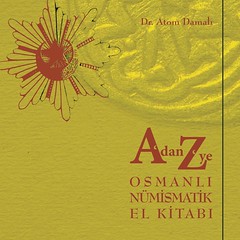 Today
there are thirty-seven states in the region which used to be the territory of the Ottoman Empire in
history. Researches have been conducted in this vast area of dynamic settlements and at the leading
museums of tens of different countries for almost a decade in order to complete the History of
Ottoman Coins. A significant archive of the Ottoman coins came into existence and "History of
Ottoman Coins", which consists of 9 volumes, was completed after the meticulous analyses and
talks that lasted weeks, months or even years with almost hundred museums and collectors in the
USA, England, Spain, France, Germany, Holland, Italy, Austria, Switzerland, Russia, Serbia, Czech
Republic, Hungary, Greece, Bulgaria, Azerbaijan, Egypt, Lebanon, Bahrain, Oman, Syria and Qatar in
addition to the ones in Turkey.
Today
there are thirty-seven states in the region which used to be the territory of the Ottoman Empire in
history. Researches have been conducted in this vast area of dynamic settlements and at the leading
museums of tens of different countries for almost a decade in order to complete the History of
Ottoman Coins. A significant archive of the Ottoman coins came into existence and "History of
Ottoman Coins", which consists of 9 volumes, was completed after the meticulous analyses and
talks that lasted weeks, months or even years with almost hundred museums and collectors in the
USA, England, Spain, France, Germany, Holland, Italy, Austria, Switzerland, Russia, Serbia, Czech
Republic, Hungary, Greece, Bulgaria, Azerbaijan, Egypt, Lebanon, Bahrain, Oman, Syria and Qatar in
addition to the ones in Turkey.
After the completion of the fundamental work, I thought that a reference book that is prepared by making use of all the information gathered within the scope of this research would be beneficial. And now, I am pleased to share with the fans of the Ottoman history this manual, which emerged in the light of this thought and which alphabetically explains phrases used in relation to coins, banknotes, medallions and other sections of the Ottoman Numismatics...
The Collection Series published by NILUFER DAMALI FOUNDATION FOR EDUCATION, CULTURE AND ENVIRONMENT, create an archive by integrating the products of numismatics, ephemera and philately into the social history.
Title: Ottoman Numismatic Manual From A to Z
Author: Dr. Atom Damali
Language: Turkish
Pages: All in colour, 254 pages
Published By: Nilfer Damali Education, Culture and Environment Foundation
Size: 210 x 210 mm
Binding: Hard cover
The book can be obtained from the website www.niluferdamalivakfi.org
REVIEWER SOUGHT FOR PLEASURE AND PROFIT
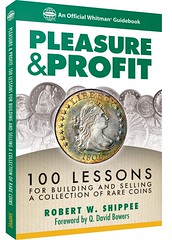
If there’s an E-Sylum reader / NBS member who would like to write a review on Bob Shippee’s Pleasure and Profit: 100 Lessons for Building and Selling a Collection of Rare Coins, I’d be happy to mail them a copy. We send out review copies to journalists, trade-paper reporters, numismatic bloggers, et al., but it’s nice to get a "non-media" reader’s comments, too.
To read the earlier E-Sylum article, see:
NEW BOOK: PLEASURE AND PROFIT
(www.coinbooks.org/esylum_v17n40a04.html)
THE 1796 MYDDLETON TOKEN
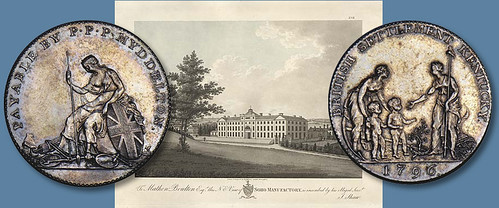
This story of one of my favorite tokens is excerpted from my 2002 More Adventures With Rare Coins, a book that showcased 50 of my favorite numismatic items. For more information, you can read The 100 Greatest American Medals and Tokens, written by Katherine Jaeger and myself, available from numismatic booksellers.
A Planned Settlement in Kentucky
In 1796 in England, Philip Parry Price, either surnamed Myddelton or from Myddelton, planned a real
estate promotion whereby British citizens were to purchase tracts of land in Kentucky. To further
this ambition, he commissioned the Soho Mint, a private enterprise operated by Matthew Boulton and
James Watt in Birmingham, to create an appropriate token or medalet. Most likely, these pieces were
produced primarily for numismatists, rather than prospective customers for land. Today, several
dozen examples exist in silver (primarily) and copper, all with Proof finish.
The obverse is inscribed BRITISH SETTLEMENT KENTUCKY and illustrates Hope (representing Britain) presenting two of her children to the goddess Liberty who welcomes them with an outstretched arm, with a cornucopia of plenty behind her, this representing the bounty of America.
The reverse shows the goddess Britannia, dejected and defeated, possibly an allegory to the loss of her citizens or, reaching back further in history, the British losing the Revolutionary War (the latter the suggestion in Walter Breen’s Complete Encyclopedia of U.S. and Colonial Coins).
From an era in which tokens and medals often carried subtle as well as obvious messages, this particular piece ranks high in numismatic interest today. And, it has been thus for a long time. In his 1875 book, The Early Coins of America, Sylvester S. Crosby paid this piece the ultimate compliment: "In beauty of design and execution, the tokens are unsurpassed by any piece issued for American circulation."
Diesinker Küchler
The dies were cut by Konrad Heinrich Küchler (usually given as Conrad H. Küchler) a gifted artist
who also prepared the three different Washington Seasons medal motifs about the same time. Striking
was accomplished at the Soho Mint, Birmingham, England.
To read the complete article, see:
(www.stacksbowers.com/NewsMedia/Blogs/TabId/780/ArtMID/
2678/ArticleID/64799/The-1796-Myddleton-Token
-%E2%80%94%E2%80%98unsurpassed-in-beauty%E2%80%99.aspx)

Archives International Auctions, Part XXI
4th Annual Wall Street Coin, Currency & Collectible Show Auction
Federal Fiscal Documents & Security Printing Ephemera
Highlights include:
- Lot 759 Palestine Currency Board, 1929 High Grade Issue
- Lot 1053 British American Bank Note Company Engravers & Printers
- Lot 400 Richmond and Petersburg Rail Road Company, 1870 Specimen Bond
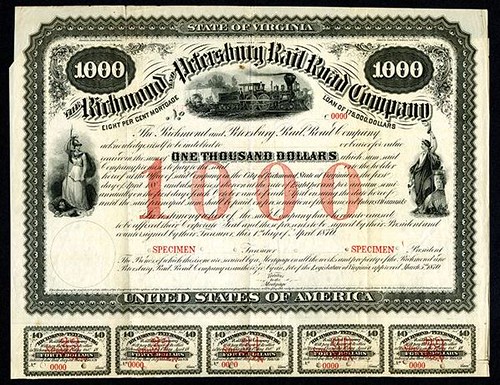
1580 Lemoine Avenue, Suite #7
Fort Lee, NJ 07024
Phone: 201-944-4800
Email: info@archivesinternational.com
WWW.ARCHIVESINTERNATIONAL.COM
A VISIT TO THE OLD SAN FRANCISCO MINT
 Julie and I are enjoying a week in San Francisco and I
had an opportunity to tour the Old Mint building over the weekend with the San Francisco Museum
& Historical Society.
Julie and I are enjoying a week in San Francisco and I
had an opportunity to tour the Old Mint building over the weekend with the San Francisco Museum
& Historical Society.
The building itself remains a magnificent landmark but has recently become the focus of a legal battle between historical societies vying for control as well as responsibility for improvement plans and future use.
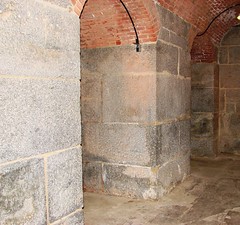
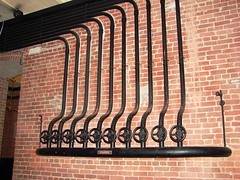
A neat experience spending time in the Old Mint and thinking about standing where people dropped off scrap silver and came back for the ingots I now treasure.
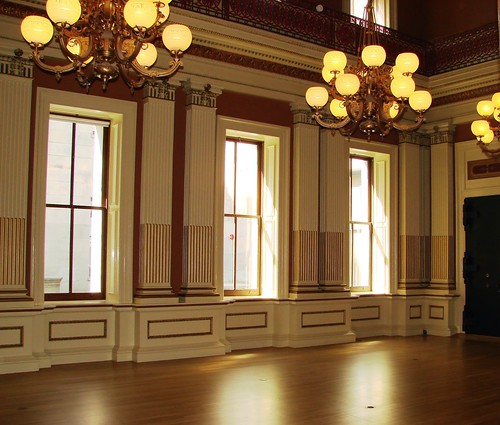
Assay Room
To read the complete article, see:
Mint
Of The United States At San Francisco Tour
(silveringot.blogspot.com/2014/10/mint-of-united-states-at-san-francisco.html)
THE ROSE MACHINE AND OTHER GEOMETRIC LATHES
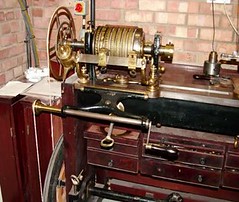
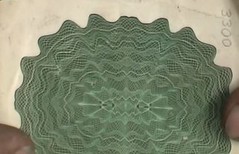
The Rose Engine and a Rose Engine Design Example
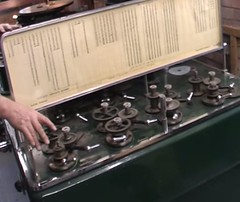
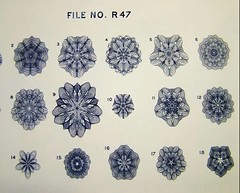
Geometric lathe and stock book of patterns
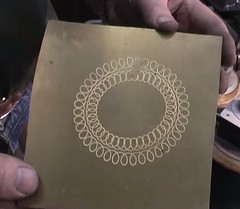
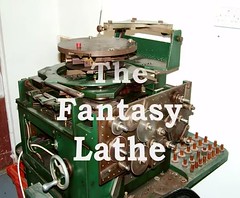
To view the complete video, see:
Banknote and Coin Engraving-.wmv
(www.youtube.com/watch?v=LJv0KpuDR1g)
THE BOOK BAZARRE
NOTES FROM E-SYLUM READERS: OCTOBER 19, 2014
Counting the Stars
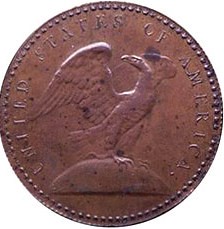 Tom DeLorey writes:
Tom DeLorey writes:
Apropos Q. David's theory on the small border stars, I see in Judd that the 1792 Wright pattern had 87 stars vs. the 94 stars on the 1794 cent die. Speculating with reckless abandon, I could see the 87 stars as commemorating the ratification of the Constitution in 1787, with some later engraver copying the idea in 1794 to indicate the last two digits of the date. However, I am dubious of the idea that the 94 stars were put in a blank die in 1792 and then held for two years before being completed with a new design.
To read the earlier E-Sylum article, see:
QUERY: JOSEPH WRIGHT 1792 PATTERN PHOTOS
SOUGHT (www.coinbooks.org/esylum_v17n42a06.html)
Vacationing at the Coin Cabinet
Regarding last week's article about Bernd Kluge of the Bode-Museum, Rich Hartzog writes:
"The only vacation available was at the Münzkabinett. " Should that be "vocation"?
To read the earlier E-Sylum article, see:
INTERVIEW WITH BERND KLUGE
(www.coinbooks.org/esylum_v17n42a16.html)
Gold Kennedy Robbery Rumors
Rich Hartzog also had a question about the gold Kennedy situation at the Chicago ANA convention
this year. He writes:
While at the ANA, I talked with a dealer who urged me to get in line to buy the Kennedy gold coins, due to the amount of money he and his family were making. He stated he knew of dealers who flew to Denver to buy coins to have them certified at the ANA. He also claimed there were at least two instances of armed robberies in the ladies room, of persons stealing newly purchased coins, from those who couldn't hold it anymore. I've not seen any other mention of that, but obviously there should be a police report somewhere. Is the ANA covering it up, or did the dealer make up the robberies?
Charles Morgan writes:
We looked into the robbery issue, talking both to ANA representatives and law enforcement personnel. I believe no robberies actually happened. Someone did leave coins in a bathroom- and they were returned by a Good Samaritan. I was at the ANA show and didn't see anything lending credibility to the robbery claims.
John Burns Estate Items Offered at PAN
Pat McBride of the Pennsylvania Association of Numismatists writes:
At the PAN show this weekend I'll have a large dealer table with all the remaining John Burns estate items for sale. This includes coins. tokens, medals, photos, correspondence and other general ephemera. Stop by and have a look.
Coins Pedigreed to Sir Arthur Conan Doyle
Larry Lee writes:
The Conan-Doyle Sale also included coins from his collection that were not ancients. A client of mine has a 1764 1/2 real from Mexico (KM-68) graded VG. She has a letter stating this coin is from the collection and that the writing on the envelope is in Doyle’s own handwriting.
To read the earlier E-Sylum article, see:
NOTES FROM E-SYLUM READERS: OCTOBER 12,
2014 : Query: Coins Pedigreed to Sir Arthur Conan Doyle Sought
(www.coinbooks.org/esylum_v17n42a07.html)
VOCABULARY WORD: TYPOGRAPHIC
Ralf Böpple writes:
A while back there was an article in The E-Sylum discussing the technical term for a medal with only text on both sides. I have tried several searches in the E-Sylum archives, but could not locate anything. Any chance that you remember the word, can do some magic with the search engine, or can ask Mr. Johnson, who as I take it knows everything in this regard?
Aha! Armed with that tidbit I located the article Ralf had seen. It had been published in July 2011. Good memory, Ralf! Here's an excerpt. -Editor
Charley became so familiar with the artists of political medals he could often identify the engraver of unsigned pieces. For example, he attributed nine such pieces to engraver James Bale (active 1824-1851). Q. David Bowers assigned two others to this same artist. These were all typographic pieces (without pictorial devices). These attributions were later verified by Wesley Cox, who made a study of diesinkers' letter punches and their diagnostic shapes (and reported by Russell Rulau).
To read the earlier E-Sylum article, see:
A FEW REMEMBRANCES OF CHARLES MCSORLEY
(www.coinbooks.org/esylum_v14n29a08.html)
VOCABULARY WORDS: COIN, TOKEN AND MEDAL SHAPES
My partner in Signature Art Medals, Mark Schlepphorst, this week asked me for a list of medal shapes. I remembered a list I compiled a few years ago and retrieved it from the computer.
I handed it to him and he read the first line, "Has there ever been an acorn shaped medal?" Yes, I replied, Medallic Art Company struck an acorn shaped medal. But what about all these other shapes? I had to admit they are also from tokens in addition to medals, as I had searched all token shapes which often included the name of the open area in the center of tokens. So call the list numismatic item shapes to cover all coins, medals and tokens.
In addition to the common name for each shape I also added the formal name. While extremely accurate, the formal name often sends a reader to the dictionary to identify its meaning. Why not just give the common name?
I like redundancy, so in cataloging I often include both terms. (Like lawyers do in writing contracts: spell out an amount then give the figures in parenthesis.) A newspaper editor wound edit out first and leave the second, they so dislike redundancy.
So here's the list of seventy-three (73) numismatic shapes:
- Acorn-shaped - Balanoid
- Almond-shaped - Mandorola
- Arrowhead-shaped - Sagittate
- Barrel-shaped - Dolioform
- Bell-shaped - Campaniform
- Boat-shaped - Navicular
- Book-shaped - Libriform
- Coin-shaped - Nummiform
- Corners cut off - Clipper corners or Handerchief corners
- Crescent-shaped - Lunular
- Cross-shaped - Cruciform
- Diamond-shaped - Lozenge or Rhomboidal
- Dome-shaped - Cupola
- Donut or anchor-ring-shaped -Toroid
- Droplet-shaped or tear-shaped - Globular
- Egg-shaped - Ovoid
- Eight-sided - Octagon
- Eye-shaped - Oculiform
- Fan-shaped - Flabellate
- Feather-shaped - Pinnate
- Fish-shaped - Pisciform
- Five-sided - Pentagon or pentagonal
- Flower-shaped - Floriform
- Four-sided - Square
- Four sided (wider at top with knotched top corners and sloping sides) - Keystone
- Foot-shaped - Pediform
- Funnel-shaped - Infundibular
- Greek letter Upsilon-shaped - Hypsiloid
- Greek letter Tau-shaped - Tau-shaped
- Half round - Lunnette
- Hand-shaped - Palmate
- Head-shaped - Capitate
- Heart-shaped - Cordiform
- Helmet-shaped - Galeate
- Horn-shaped - Cornual
- Horseshoe or omega-shaped - Omegoid
- Human-shaped - Hominiformn
- Ivy-shaped - Hederiform
- Key-hole-shaped - Clithridiate
- Kidney-shaped - Nephroid or Reniform
- Leaf-shaped - Foliform
- Lens-shaped - Lenticular
- Mouth-shaped - Oriform
- Nine-sided - Nonagon
- Oval-shaped - Ellipsoidal
- Oval (vertical) with two pointed ends - Vesica piscis
- Pear-shaped - Pyriform
- Pouch or purse-shaped - Bursiform
- Ring-shaped - Annular or Cricoid
- Rounded top, square bottom - Tombstone
- S-shaped - Sigmoid
- Saucer-shaped - Scyphate
- Seven-sided - Heptagon
- Shell-shaped - Conchiform
- Shield-shaped - Scutiform
- Six-pointed star shape - Pentacle
- Six-sided - Hexagon
- Spiral-shaped - Volute
- Star-shaped - Stellate
- Ten-sided - Decagon.
- Three-sided - Triangular or Triquetra
- Tooth-shaped - Dentiform or Dentilated
- Tree-shaped - Dendriform
- Twelve-sided - Duodecagon
- Twenty-sided - Icosagon
- Twenty-four-sided - Tetraicosagon
- U-shaped - Hyoid
- Urn-shape - Urceoform
- Violin-shaped - Pandurate
- Wavy rounded edges - Scalloped
- Wedge-shape.- Cuniform
- Wing-shaped - Aliform
- Without symmetric form - Free-form
If the shape you are seeking is not listed above -- and it's not free-form -- use the term "unusual shape." But remember if it is silhouetted, as around the head of a person, that is not an unusual shape -- it's just "silhouetted."
Editor Wayne Homren was thrilled with one term (typographic, see above). He ought to be ecstatic with seventy-three (73)!
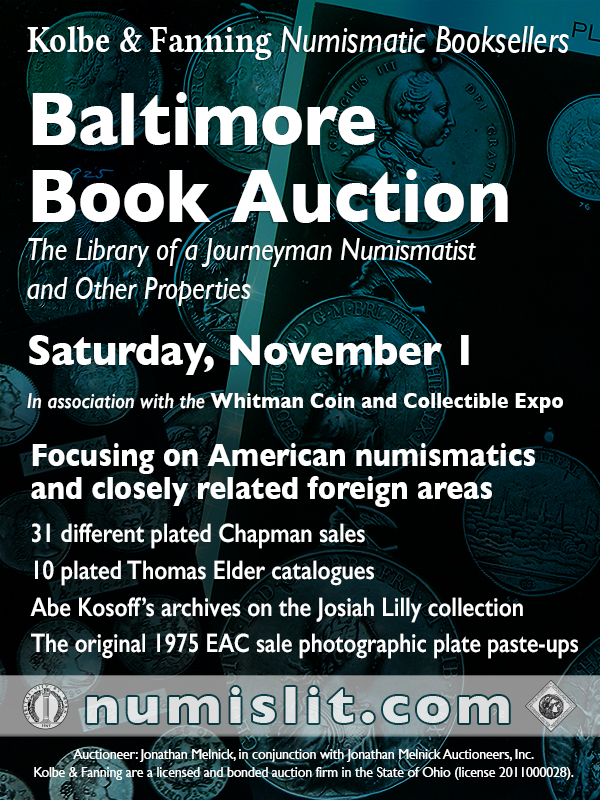
BOB EVANS REVEALS LATEST SS CENTRAL AMERICA DISCOVERIES
"The many treasures of the S.S. Central America" is the featured talk to be presented by Mr. Bob Evans, Chief Scientist and Historian of the S.S. Central America Project, and the Co-Discoverer of the shipwreck site. His presentation is scheduled for Friday, October 24th at 3:00pm at the Monroeville Convention Center, near Pittsburgh, PA and is part of the PAN Fall Coin Show and Convention.
Bob’s talk can be described best in his own words,
"The idea here is that the treasure we found this year is not monolithic, comprising several distinct and separate components spread over a wide area the size of a village. It included the remainder of the commercial shipment that we did not recover in 1988 - 1991. Then there was the ship's safe and the wonders within, including what appears to be the ship's actual business operating funds, unlike any other treasure I know. The safe also held what appear to be some passenger consignments, including a treasure vest that would allow the owner to wear his wealth while transporting it. (Amazing!)"
"Then there are many of what we dubbed "coin piles," fairly coherent deposits of coins found in the debris field and within the shipwreck apart from the commercial shipment. Several of these would qualify as amazing treasures themselves if found in an abandoned building or buried in a garden. Each is a time capsule of a particular person's style, nationality, perhaps their profession. Interesting is that none can be tied to a specific person, even though we looked for that kind of evidence and found many engraved pieces of jewelry with names and initials. My conclusion at the moment is that the jewelry must have been gifts intended for east coast recipients, or payments taken for gambling or other debts. (Fascinating!)"
Bob is also our featured banquet speaker on Friday evening. We have held a block of tickets for those that may still want to come even though we are past the RSVP deadline. Just email us at pancoins@gmail.com. PAN would like to make this unique event available to as many as possible. More information can be found on the PAN website.
For more information on the PAN Show, see:
www.pancoins.org
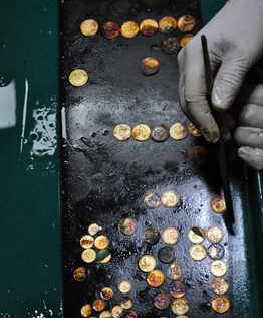 Over 2,000 individual items were recovered during
this reporting period including over 1,000 gold coins in a wide range of denominations, dates and
mint marks, including privately-minted gold coins and rarer smaller denomination gold coins. 61
pieces of gold jewelry were also recovered. Following a pattern seen during early jewelry
recoveries, many jewelry pieces were crafted of large gold nuggets.
Over 2,000 individual items were recovered during
this reporting period including over 1,000 gold coins in a wide range of denominations, dates and
mint marks, including privately-minted gold coins and rarer smaller denomination gold coins. 61
pieces of gold jewelry were also recovered. Following a pattern seen during early jewelry
recoveries, many jewelry pieces were crafted of large gold nuggets.
The cultural heritage artifacts recovered include luggage tags, pieces from a music box, a padlock with key, brass bullet molds, and several daguerreotypes and ambrotypes.
The daguerrotypes and ambrotypes recovered from the SS Central America shipwreck site have been hand- transported to a specialist photography conservation lab where they are being assessed before active conservation begins.
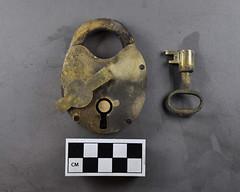

To read the complete article, see:
Report on Activities at SS
Central America Shipwreck Site July 16, 2014 – August 15, 2014
(www.shipwreck.net/documents/OMECourtReport14-4.pdf)
1715 FLEET SOCIETY TO EXHIBIT SUNKEN TREASURE

The 1715 Fleet Society will be sponsoring an exhibit of sunken treasure at the Pennsylvania Association of Numismatists Coin Show in Monroeville, PA, October 23 to 25, 2014. The Fleet Society is a group of historians, educators, and numismatists deeply interested in the loss of the 1715 Spanish Fleet.
The treasure fleet was lost in a massive hurricane off of the east coast of Florida, July 31, 1715. Starting in 2008, the Fleet Society began developing a mission for commemorating this event. First and foremost that mission is to promote public awareness through education regarding the upcoming 300th anniversary of this tragedy.
The exhibit being sponsored by the Society consists of many unique relics recovered from the 1715 Fleet wreck sites. Included are both numismatic and non-numismatic items. Silver pieces of eight as well as silver bars, silver wedges, and gold splashes are just a few of the featured items. In addition there will be some items from other shipwrecks including the Atocha.
The Fleet Society is also involved in helping to organize an exhibit consisting of treasures from the State of Florida Collection which is scheduled to be displayed at the Florida United Numismatists Show in Orlando, FL in January of 2015. The 1715 Fleet Society Directors are Ben Costello of Washington, PA; Ernie Richards of West Palm Beach, FL; and Phil Flemming of Scottsdale, AZ.
For more information on the society, see:
www.1715fleetsociety.com
BLOOM'S LAW OF THE PROFITABLE INERTIA OF GOLD
An amusing aside that might be of interest to E-Sylum readers:
This weekend I was reading Paul Dickson’s The Official Rules (Delacorte Press, 1978; subtitled The Definitive, Annotated Collection of Laws, Principles, and Instructions for Dealing With the Real World) when I came across this entry: "Bloom’s Law of the Profitable Inertia of Gold: Certain things shouldn’t be moved."
Dickson ascribes the concept to Murray Teigh Bloom, writing in his book on counterfeiting, Money of Their Own (Scribners, 1957).
"As [Bloom] explained in a recent letter, ‘Once the Philadelphia Mint experimented and found $5.00 was lost by abrasion every time a million dollars worth of gold coin was handled. Just lifting the bags—each filled with $5,000 worth of gold coin—to the truck resulted in a $5.00 loss; transferring them back to the mint caused another $5.00 loss. Letting the stuff rest quietly at Fort Knox instead of moving it around nervously to Sub-Treasuries makes us richer.’"
I’d never heard of Bloom’s Law, or of this Philadelphia Mint experiment. Sounds more like a parable or a numismatic urban legend!
Dave Bowers writes:
I will call the manager of my gold vault in Manhattan and tell him to not even wiggle a gold bar.
Joel Orosz writes:
Thanks to Grandfather Orosz's heavy investment in the Ace Buggy Whip Co. back in 1910, I am spared the need to move bags of gold from bank to bank!
What delightful story this is, and if it is not true it ought to be! Unfortunately, I don't own a single book by Murray Teigh Bloom, so I can neither confirm nor deny the accuracy of this claim.
Let's just hope that, in this political season, no bloviator running for Congress gets hold of this information. If so, they can claim that their decision to do absolutely nothing for the past 6 years has actually been a successful deficit-reduction strategy!
Dennis Tucker adds:
I think Dickson was quoting personal correspondence from Bloom ("a recent letter," he says), as opposed to quoting from Bloom's book. He does, however, cite Bloom's Law as coming from the counterfeiting book. If I understand correctly, then, Bloom's story comes from a letter, but his Law is in his book. [... somewhere. -Editor]
THE BOOK BAZARRE
SELECTED LOTS FROM KOLBE-FANNING SALE #137
Lot 1: Edgar Adams' Notebook on Connecticut Cents Etc.

Adams, Edgar H. CONNECTICUT CENTS. HIGLEYS. NEW YORK (NOVA EBORAC). CONFEDERATIOS. VERMONT CENTS. WOODS TOKENS. (New York, undated, 1920s?). 110 leaves, some utilized on both sides, as follows: Title leaf (cited above). Connecticut Cents section: 46 leaves, containing a pencil list of varieties, with illustrations of about 140 different varieties, mostly depicting both sides, largely being photographs or photographic illustrations, with pedigrees and prices where known.
1) Higley section: 6 leaves, with typescript descriptions and pencil annotations, 3 illustrations (one holed, several others appearing to have long ago been removed).
2) Confederatio section: 6 leaves, with typescript descriptions and pencil annotations, 2 illustrations (a few others appear to have long ago been removed).
3) Nova Eborac section: 2 leaves, with typescript descriptions and pencil annotations, 14 illustrations, mostly photographic.
4) Vermont section: 15 leaves, with typescript descriptions and pencil annotations, 42 illustrations, mostly photographic (several others appear to have long ago been removed).
5) NE Massachusetts section: 1 typescript leaf, no illustrations.
6) Mark Newby section: 4 leaves, with typescript descriptions and pencil annotations, 17 illustrations, mostly photographic.
7) Wood's section: 29 leaves, listings in pencil and typescript, with ink annotations, almost 90 illustrations of both sides, nearly all photographs.
8) 8.5 by 11 inch sheets, housed in an early 20th-century gray cloth three-ring binder, spine titled in ink. A leaf or two of the contents are comprised of printed Edgar H. Adams stationery. Ex June 13-15, 1967 New Netherlands sale, part of lot 25: "Presumably prepared by Edgar H. Adams for Julius Guttag." American Numismatic Society Library Dictionary Catalogue page 11 (a similar production).
Lot 2: Edgar Adams' Notebook on New Jersey Cents, etc.
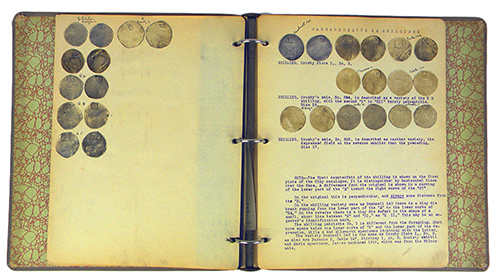
Adams, Edgar H. MASS. (New York, undated, 1920s?). 59 leaves, occasionally utilized on both sides, as follows:
1) Cents of New Jersey section: 17 leaves, consisting of two sacrificed copies of the Guttag work, mounted on blank leaves.
2) Massachusetts NE Shillings section: 2 leaves, with typescript descriptions and pedigree notes in ink, 14 obverse and 14 reverse photographic illustrations (half original photos and half from major Chapman sales).
3) NE Massachusetts Sixpence section: 1 typescript leaf, long typescript description, ink pedigree note, illustration from Bushnell catalogue.
4) NE Massachusetts Threepence section: 2 typescript leaves (second blank), typescript descriptions, ink note pertaining to original mounted photograph: "Guttag. This piece is not the genuine piece illustrated by Crosby. Neither is it from the Clay counterfeit dies." Two other illustrations appear to have long ago been removed.
5) Willow Tree Shillings section: 2 typescript leaves, one description in ink, 8 illustrations, 7 being original obverse/reverse photographs.
6) Willow Tree Sixpence section: 1 typescript leaf, obverse/reverse photographs of one variety (Bushnell illustration appears to have long ago been removed).
7) Willow Tree Threepence section: 1 typescript leaf, obverse/reverse photographs of one variety with pencil note: "Guttag has a specimen."
8) Oak Tree Shillings section: 3 leaves, with typescript descriptions and pedigree notes in pencil, 22 obverse/reverse illustrations, over half from classic Chapman sales, several original photographs, including two depicting Ellsworth coins, the Crosby 8 termed "Probably finest known."
9) Oak Tree Sixpence section: 2 typescript leaves, with typescript descriptions and pedigree notes in pencil, 9 obverse/reverse photographic illustrations.
10) Oak Tree Threepence section: 1 leaf, with typescript descriptions and pedigree notes in pencil, 3 obverse/reverse photographic illustrations (several others appear to have long ago been removed).
Lot 8: Bathe, Jacob Perkins
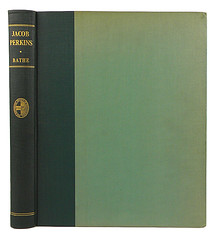

Bathe, Greville and Dorothy. JACOB PERKINS: HIS INVENTIONS, HIS TIMES, AND HIS CONTEMPORARIES. Philadelphia: Historical Society of Philadelphia, 1943.
Number 170 of 200 copies printed of this modern classic and notable rarity. Greville and Dorothy Bathe's biography of Jacob Perkins (1766-1849) is widely considered to be a masterpiece on several levels.
Lot 22: Bushnell's Arrangement of Tradesmen's Cards
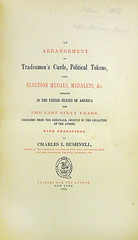 Bushnell, Charles I. AN ARRANGEMENT OF
TRADESMEN'S CARDS, POLITICAL TOKENS, ALSO, ELECTION MEDALS, MEDALETS, &C. CURRENT IN THE
UNITED STATES OF AMERICA FOR THE LAST SIXTY YEARS, DESCRIBED FROM THE ORIGINALS, CHIEFLY IN THE
COLLECTION OF THE AUTHOR. WITH ENGRAVINGS. New York: Printed for the Author, 1858.
Bushnell, Charles I. AN ARRANGEMENT OF
TRADESMEN'S CARDS, POLITICAL TOKENS, ALSO, ELECTION MEDALS, MEDALETS, &C. CURRENT IN THE
UNITED STATES OF AMERICA FOR THE LAST SIXTY YEARS, DESCRIBED FROM THE ORIGINALS, CHIEFLY IN THE
COLLECTION OF THE AUTHOR. WITH ENGRAVINGS. New York: Printed for the Author, 1858.
Along with Bushnell's 1859 work on New York tokens (vide infra), a fundamental early U.S. text on a specific numismatic topic. Bushnell's descriptions are detailed and thorough, setting a fine example for those wishing to follow in his footsteps. Important and scarce. Clain-Stefanelli 13993*. Ex Harry W. Bass library, with his bookplate (Sale 80, lot 101); ex June 12-13, 1981 Kolbe sale, lot 624.
For more information on the sale, see:
www.numislit.com
AN ODD 1793 WREATH CENT
 When I displayed this 1793 Wreath Cent coin at the recent New
Hampshire Coin Expo, a few people opined on how it came to be. The most popular theories were:
When I displayed this 1793 Wreath Cent coin at the recent New
Hampshire Coin Expo, a few people opined on how it came to be. The most popular theories were:
1. Simply a memento, perhaps to be worn around the neck.
2. A few people thought, because of the degree of wear on the coin, that it might be a crude, hand made Civil War dog tag.
3. Lastly, one person thought it might be a toe tag for someone who was recently deceased, to identify the body.
I'm not sure what to make of it myself. Perhaps it was simply the work of idle hands one afternoon circa 1840-1870. The only thing I can say for sure was that it was done by someone who was unaware of its value as a numismatic item,.
I'd be interested in the thoughts of E-Sylum readers.
To vist Dave's web site, see:
www.davewcoins.com

WAYNE'S NUMISMATIC DIARY: OCTOBER 19, 2014
On Tuesday I made my way after work to the Mad Fox Brew House in Falls Church, VA for the monthly dinner meeting of my numismatic social club, Nummis Nova. I arrived at 6pm and picked a spot across the tale from Jon Radel, who'd been the first to arrive. The meeting would be a little smaller than usual - regulars Gene Brandenburg, Aaron Packard and Joe Levine were all sidelined for health issues, and Roger Burdette had a family health matter to attend to.
The table soon filled up though. Joining us were Ron Abler, Dave Schenkman, Tom Kays, Steve Bishop, Mike Packard, Eric Schena, Julian Leidman, Wayne Herndon, and Howard Daniel. Soon the finely crafted microbrews and conversation were flowing freely.
I started by telling Eric Schena how I'd seen his profile in The Numismatist. I passed around my copy of the issue for everyone to see, then gave it to him so he'd have a hardcopy. There goes my complete set... (Not to worry, though - two members have offered up their copies as a replacement).
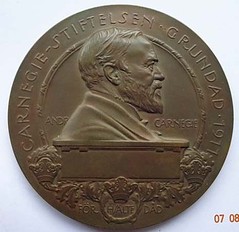
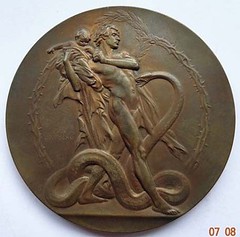
I also passed around my latest numismatic acquisition, an unawarded medal from the Swedish Carnegie Hero Fund (an eBay purchase). I've made a minor specialty of these, and was glad to be able to pick this one up.
Dave Schenkman had three nice British medals. He provided the following images and captions. Thanks!
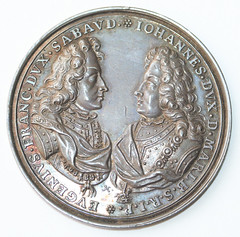
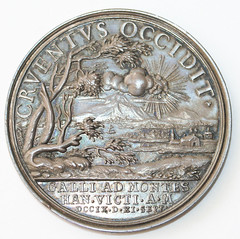
1709 medal: Prince Eugene of Savoy and the Duke of Marlborough.
Silver, 44mm. Eimer 439
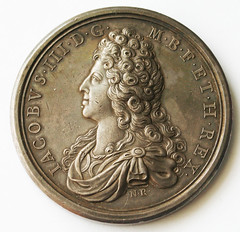
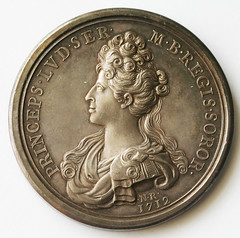
1712 memorial to the death of Princess Louisa.
Her brother, James III, is depicted on the obverse.
Silver, 51mm Eimer 454.
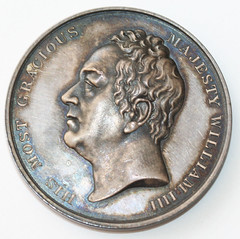
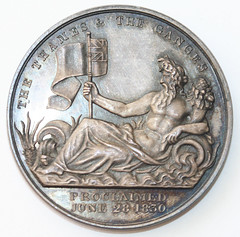
1830 medal: Accession of William III; the reverse depicts Neptune.
Silver, 43mm. Brown 1425, but unlisted in silver.
Dave said he'd set these aside many years ago after buying a collection at a coin show. I told him I wished I owned half of the coins, tokens and medals he'd forgotten he had.
I'd forgotten to ask him another question that had been on my mind since hearing an old song on the radio. Dave's a banjo expert, and I wondered how it was the predominant instrument in The Who's Squeezebox, a song ostensibly about a woman playing an accordion, is a banjo. Ah, the Mysteries of Life...
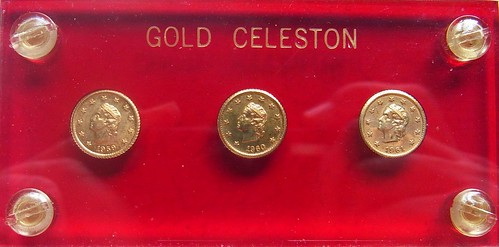
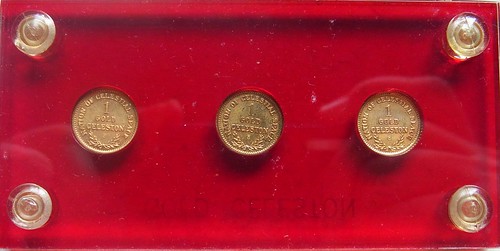
Another interesting group of coins passed around was this set of three gold Celestons (1959, 1960, 1961). See Tom Kays' article elsewhere in this issue for more background information. These got us into a conversation about micronations in general, and Tom was a fountain of information thanks to his recent reading of a do-it-yourself book on "How to Start Your Own Country ". We came up with the alternate title "Micronation Statecraft For Dummies"
You might guess by that advanced point in the evening’s festivities that selections of finely crafted microbrews were flowing freely, making some of us see micronation statecraft in an especially attractive light, as though seen through "beer goggles." Now some of the dinner party did not drink, so I leave it to you to decide which among us naturally tend to see the world tinted through "beer goggles." Not a bad thing, right?"
I passed on dessert and paid my tab. It was another fine night of numismatic fellowship. 'Til next time!
THE NUMISMATIST PROFILES ERIC SCHENA
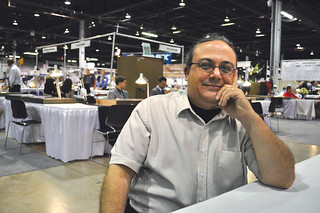 Eric Schena wants to keep history alive by telling others about
his numismatic discoveries. After all, he explains, "What good is this knowledge if you can’t
share it?"
Eric Schena wants to keep history alive by telling others about
his numismatic discoveries. After all, he explains, "What good is this knowledge if you can’t
share it?"
Schena’s primary collecting interests are the coins, paper money, tokens and related ephemera of the Mid-Atlantic region, including medals, souvenir badges, honors and decorations. Schena has lived in the area since 1984 and currently resides in Cross Junction, Virginia. He has dedicated a large portion of his numismatic career to documenting the territory’s rich history.
One of Schena’s collecting focuses is trade tokens, and he says he "discovered early on that a lot of information pertaining to them is vanishing." Much of what is known about some pieces, especially so-called "mavericks" (those with no identifying features to indicate where or by whom they were issued) is passed down through word of mouth. He says this is especially true of cannery ¬tokens and "picker’s checks" from the Eastern Shore. As the people who used these pieces die, their stories are lost, and, once gone, this part of the American experience can never be regained.
Schena’s grandparents introduced him to the hobby. His grandfather Bev gave him a small bag of Wheat cents when he was 4 years old, and from then on, he was hooked. His grandmother, whose nickname was Penny, saved cents and let Schena pick out the ones he wanted. His other set of grandparents, Tony and Nan, "aided and abetted" his explorations of numismatics by giving him a coin bank full of silver dimes, and when his mother went to work as a bank teller, she pulled Eisenhower dollars and other coins from circulation for his collection.
As a teenager, Schena worked part-time at Old Town Coin & Jewelry Exchange in Alexandria, Virginia. He spent many hours researching and attributing Greek and Roman coins at Gene Brandenburg’s store, and went on to earn a bachelor’s degree in Greek and Roman archeology from The College of William & Mary in Virginia.
Brandenburg was a mentor who taught Schena about some of the less-traveled paths in numismatics. Schena says, "It is through him that I developed my lifelong passion for collecting tokens and obsoletes from Virginia, starting with a ‘good for’ token from the Southern Operating Company of Norfolk, a piece still in my collection."
At Gene’s shop, he also met Dave Schenkman, with whom he shares a common love of exonumia (and, as it turns out, muscle cars). He is honored to be laying out the upcoming revision of Schenkman’s 1980 book, Virginia Tokens, and says the work has been "a labor of pure joy."
Since graduating from college, Schena has held various jobs related to information technology. He currently is a contractor for Fannie Mae and also works part-time as a cataloger/consultant for Stack’s Bowers Galleries. His wife and numismatic partner, Heather, attends coin shows with him and pushes him to write more.
A member of the American Numismatic Association, Virginia Numismatic Association, Numismatic Bibliomania Society, Numismatic Literary Guild, and Token and Medal Society, Schena was named to the latter’s board of directors at the 2014 World’s Fair of Money in Chicago. Last year, he published the award-winning Ingle System Scrip of the Mid-Atlantic Region.
Schena encourages those new to numismatics to get involved in their local collecting community. "There are a lot of really fine folks in this hobby," he says. Like him, they always are willing to impart their wisdom to newly minted collectors.
For more information about the American Numismatic Association, see:
www.money.org

U.S. SEMIQUINCENTENNIAL CELEBRATION PLANNERS WANTED
 Ron Abler, recent e-book author and researcher of the
Medals of the 1876 American Centennial noted over a Dos Mundos IPA microbrew, that
Philadelphia did a dandy job hosting the festivities in 1876, but we as a nation just couldn’t get
it together in 1976 for the Bicentennial, where every state and Congressman wanted to party in
their own district, rather than holding a big, national event, akin to a World’s Fair in
Philadelphia.
Ron Abler, recent e-book author and researcher of the
Medals of the 1876 American Centennial noted over a Dos Mundos IPA microbrew, that
Philadelphia did a dandy job hosting the festivities in 1876, but we as a nation just couldn’t get
it together in 1976 for the Bicentennial, where every state and Congressman wanted to party in
their own district, rather than holding a big, national event, akin to a World’s Fair in
Philadelphia.
Here we go again with the Semiquincentennial (Quadra-milennial?) or 250th Birthday Bash which looms a scant twelve years away. We barely have time to plan the event, and Ron is adamant that Philadelphia should host a major event on par with the Centennial festivities of 1876.
Time to mount a letter writing campaign to the Mayor of Philadelphia, the Governor of Pennsylvania, and any Federal Commissions that may be charged with noting a quarter millennium of American freedom has passed by, that it still means something, and is worth celebrating, with perhaps a Philadelphia Freedom Fair and issuance of a series of medals recreating the grandeur of those 1876 Centennial medals. By now the copyrights must have expired, right? Just change "187_" to "202_" and there you go. I assert the central pavilion must be named after Ron Abler (and any corporate sponsor(s)), who just may save the nation further embarrassment by getting this party started.
MICRONATION STATECRAFT FOR DUMMIES
Seen at the October 2014 Nummis Nova dinner was a short set of three gold Celestons, currency of the Nation of Celestial Space. Be it known, Celestia encompasses all hitherto unclaimed territory (by humanity) including the known universe, less the Earth itself.
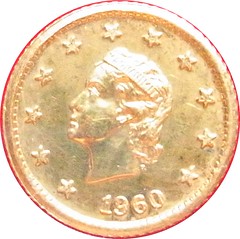
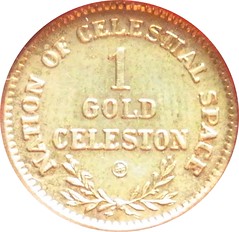
Declared on January 1, 1949 (Earth Calendar) by the far seeing "First Representative" James T. Mangan, formerly of Evergreen Park, Illinois, United States, Earth; at its inception, nineteen humans claimed to belong to the new nation through primogeniture, including Mangan’s daughter Ruth (Stump), Princess of the Nation of Celestial Space, who later bore three sons, all Dukes as it turned out, including Todd Stump, Duke of the Milky Way.
The Nation of Celestia is still remembered through stamps, coins, videos, and its flag, a white "hashtag" on blue disk in a field of white that frankly reminds me of South American Spanish colonial coins that read "Plus Vltra" along the center tic-tac-toe line, meaning "more beyond".
James T. Mangan claimed something for which "Ne Plus Vltra" really does apply, and he did so at an auspicious time when the United Nations was new. Showing up in New York with a snazzy flag and asking for diplomatic credentials, he got them, along with a solemn (and televised) flag raising ceremony at the U.N. in 1958 at the dawn of the "Space Age."
Now when it came time to collect tariffs from, and issue passports to the first Russian Cosmonauts who ignored his demands, and the first American Astronauts in 1961, diplomatic relations with Celestia hit a rocky patch among the increasingly surly Earth-bound (I should say "space bound") nations.
It would have been a good move to provide the cosmonauts and astronauts with Celestia passports free of charge, with the traveler’s picture and requiring their signatures, under the stipulation that passports be carried at all times when in Celestia, and that they would be subject to surrender to the First Representative upon expiration for reissue.
Imagine if the Mercury Seven Astronauts had autographed and carried Celestia Passports into space and back. "Godspeed John Glenn, and please remit $10 for a Celestia visa stamp for each orbit." Just an idea if this ever crops up again. In fact common mistakes in micronation statecraft like this, really need a "How-to" manual or "Micronation Statecraft for Dummies?" to be written.
 You may be surprised to learn there is such a
tome, entitled "How to Start Your Own Country - How You Can Profit from the Coming Decline of
the Nation State" written by Erwin S. Strauss a resident of Fairfax County, Virginia in 1983.
From the flyleaf: Mr. Strauss
You may be surprised to learn there is such a
tome, entitled "How to Start Your Own Country - How You Can Profit from the Coming Decline of
the Nation State" written by Erwin S. Strauss a resident of Fairfax County, Virginia in 1983.
From the flyleaf: Mr. Strauss
"was born in Washington D.C. and grew up along Embassy Row. He lived in Europe and Asia with his German-born father, a consul and First Secretary in the Diplomatic service of the United States who served in American missions in Paris and Bangkok. After being expelled from the Massachusetts Institute of Technology for a book importing operation that undercut the campus bookstore and publishers owned by M.I.T. and its faculty members, he returned there and received a Bachelors of Science degree in 1967…He occasionally serves in a consulting capacity to new country projects."
We learn that there are at least five basic approaches to nation building including
1) traditional sovereignty with its requirements for a population, defined location, shared vision, membership in the U.N., ambassadors and passports and all. You can probably name a few countries like that.
2) Most profitable are "ships under flag of convenience" which are basically allowed to fly their own flag, in international waters, but often only after tribute is paid to the nearest friendly, safe harbor nation that sanctions pirate-like operations, which in modern times we think of pirate radio stations and duty free shopping.
3) By means of litigation, one may simply declare independence, but it takes ages and much understanding (and legal fees) within the emancipator nation, and is not recommended for run-of-the-mill founding fathers.
4) "Vonu" (pardon my Esperanto) means "out of sight – out of mind," and refers to groups of likeminded citizens who drop from sight to found their own Utopias in uncongested parts of the world. Homesteaders in Antarctica, Pitcairn Islanders (after the Mutiny on the Bounty), and Mormons of Salt Lake City who issued gold coins thru 1860, and other groups of whom you are not aware, are good examples.
Lastly, 5) Model Countries which Mr. Strauss likens to running model railroads, but instead of track and rolling stock, the nation-building hobbyist designs their own stamps, coins, issues their own currency, prints their own money.
Now I’ve got your attention. The trick is to get other nations to accept your new stamps and coins, and especially for tourists to buy them for more than face value. Making them from one troy ounce of silver, for instance, as did H.R.H. Prince Leonard of the Principality of the Hutt River Province, in the vicinity of Australia, who discovered his coins circulating in Hong Kong, may be counted a success for the Model Nation Builder. Theoretically, the first issue of coins from every country started from such humble beginnings.
The International Micropatrological Society tracks the status of various nation building projects and may act as a clearinghouse for those who collect "One From Each Country" (OFEC), when they are ready to go for the gusto of typically rare, micronation issues.
Celestia for example, issued gold "Celestons" of Princess Ruth in 1959, 1960 and 1961 in uncirculated and proof, (one variety with a small "R"), in 0.900 fineness, at 2.2 grams, and with an emission of about 450 pieces.
Each Celeston equals ten silver "Joules" of 4.15 grams Sterling. A Joule equals ten "ergs." Some influential micronation coin issuers whom we applaud, include one of the many Atlantis attempts termed "Operation Atlantis" which issued the "Deca," the Island of Lundy which issued "Puffins," the Conch Republic (Key West), the Cocos Islands, the Republic of Minerva, Sealand, being a WWII era anti-aircraft platform seven miles from the mouth of the River Orwell, off the Essex Coast of England, the Sultanate of Occussi-Ambeno, under Sultan Sir Wallis Abdullah I, in the vicinity of Timor, Indonesia, but with a post office box in New Zealand, and the Independent Republic of Granbia, located in a semi-detached house in Liverpool, England under King Andrew I (formerly known as Andrew Richardson, a postman). Bravo!
Besides minting coins, micro nations may do well in bestowing noble titles, such as those sold (I mean bestowed for an honorarium) by King Richard, of the Kingdom of Hay, whose royal treasure house consists of a used book emporium in a small village in Wales. Knighthoods, Earldoms, Dukedoms, Baronetcies, and regal posts including Herald Extraordinary, Poet Laureate, Royal Forrester, and Admiral of the Fleet await, perhaps as a surprise for your hard-to-buy-for friends who have everything already.
Where is all this micronation statecraft advice leading? Micronations traditionally require a defined territory to qualify, yet after the dawn of the Space Age came the dawn of the Age of Virtual Reality. A few examples of emerging virtual micronations such as the Society for Creative Anachronism were mentioned in Mr. Strauss’ book, but today entire virtual communities, cloud computing consortiums, and virtual worlds (think Minecraft), come with virtual coins (some offered in exchange for Bitcoins, PayPal credits, or iTunes Gift Cards, worth real money). They do exist in cyberspace, no longer needing a physical place to plant their flag.
Virtual Micronation Statecraft for Dummies, anyone?
To read the complete article, see:
How to Start Your Own Country
(archive.org/details/HowToStartYourOwnCountry)
REVIEW: DAVID HENDIN LECTURE ON BIBLICAL COINS
ANS in Springfield
On October 14th, ANS Adjunct Curator David Hendin will offer "Insights on the Biblical
Narrative from Judean and New Testament Coins" as part of the Green Scholars Initiative
Speaker's Series in conjunction with the exhibit "Passages: Treasures of the Bible in
Springfield, Missouri."
This appeared in the September 2014 Enews of the American Numismatic Society
A half a dozen members of the Ozarks' Coin Club attended this lecture, some with little knowledge of the subject. Not to worry. The lecture might well have been titled. "A Funny Thing Happened on the Way to the Temple." David Hendin has a very mobile face reminiscent of Jack Gilford who played Hysterium on Broadway and in the film, A Funny Thing Happened on the Way to the Forum. Hendin was Hysterium in modern dress and with nary a note told his audience the story of the coins of the Bible hop scotching from myth to fake to hoard all in timeline order.
The Widow's Mite... not so fast. The Shekel, well... which one? The 30 Pieces of Silver...just a standard price for treachery with many historic precedents. And then the story of the money changers in the temple illustrated by Rembrandt with Hendin's Hysterium playing all the changers shouting out their rates to get your attention.
It was fascinating. This reviewer knew most of the terms before, if only from doing cross word puzzles and being a Shabbes goy, but Hendin brought this collection of old numismatic stuff together into a coherent whole from high priest to king to procurator and back again with dozens of coin illustrations to help identify the players.
Should this lecture play at a local Temple or Forum near you, it is highly recommended.
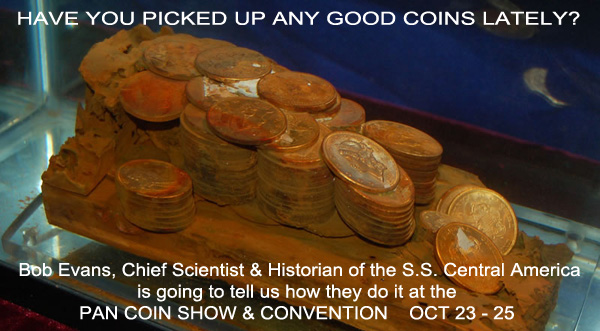
DIRTY MONEY RUMORS AND EBOLA
I was asked today if you can catch Ebola from coins or paper money. I looked quickly on the Internet and the disease is spread by direct contact with bodily fluids, so presumably the answer is no.
I wondered if there have been health scares before where coins were suspect. Apparently during the plague in England in the Seventeenth Century smallholders from the villages around London were unable to enter the city and left vegetables in market areas, and sold their goods by shouting. They collected their payment after the money had been left in a bucket of water to "disinfect" the coins.
As late as 1990 there was an outbreak of bubonic plague in Glasgow which lead to calls for disinfecting all the trams, all the ferries, even all the coins which are in people's pockets in case they should carry some kind of contagion.
Probably you cannot catch disease from coins but by being generous with them you can help prevent it. What do readers think?
MORE SELECTIONS FROM THE STACK'S BOWERS 2014 BALTIMORE SALE
1853 Pattern Cent. Judd-149
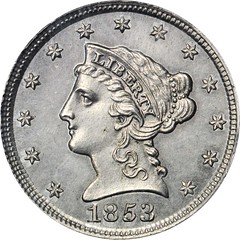
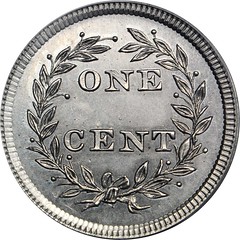
1853 Pattern Cent. Judd-149, Pollock-178. Rarity-6+. German Silver. Reeded Edge. Proof-64 (PCGS). CAC.
Obv: The same design that the Mint used to strike regular issue 1853 Liberty quarter eagles. Rev: The denomination ONE CENT within a laurel wreath; the same design used to strike the Judd-124c example offered above.
Medium steel gray with some traces of pale blue in the somewhat reflective fields. Sharply struck and quite attractive. An interesting pattern combining the standard quarter eagle obverse design with a new one cent reverse. An interesting lack of precision is noted in the die work. The E of CENT was original punched much higher, then corrected. Strong artifacts of the earlier erroneous placement are clearly visible on this piece.
To view the complete lot description, see:
1853 Pattern Cent. Judd-149, Pollock-178. Rarity-6+. German Silver. Reeded Edge.
(www.stacksbowers.com/BrowseAuctions/LotDetail/
tabid/227/AuctionID/6039/Lot/10054/Default.aspx)
1853 New York Crystal Palace Medal
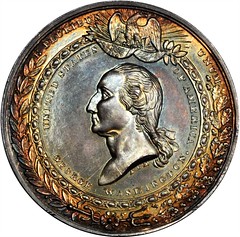
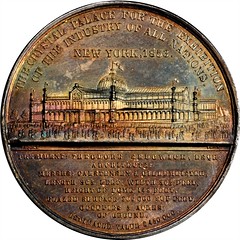
853 New York Crystal Palace Medal. Silver. 51.5 mm. 56.9 grams. Baker-361. Rarity-8. Choice Mint State.
Outstanding 1853 Crystal Palace Medal in Silver
Obverse by Alexander C. Morin, of Philadelphia, his mark below Washington’s truncation. Reverse by Anthony Paquet, his name at the lower left of the central motif. An exceptionally beautiful example of this rare medal, in the most precious of known compositions. The toning is bold and original, and of the style typically seen imparted by long-term cabinet storage in old-time collections.
The obverse is blended pale blue, violet and pearl gray near the center, while bright gold, rose and blue appear around the rims. The reverse is accented by light rose, blue and sea green. Bold prooflike reflectivity on both sides with a rich satin frost on the motifs. One small abrasion is noted on Washington's truncation, but otherwise the medal is remarkably free of all but the most minor handling. The aesthetic appeal is nothing short of exquisite, and it is every bit the equal of the beautiful Zabriskie Collection specimen that appeared in our March 2013 sale of the Charles A. Wharton Collection.
Appearances of this medal can be quite infrequent, and the appearance of two this year is a remarkable anomaly. They command intense attention when they do appear, as seen in both the Zabriskie sale of 1999, as well as in our March sale.
To view the complete lot description, see:
1853 New York Crystal Palace Medal. Silver. 51.5 mm. 56.9 grams. Baker-361.
(www.stacksbowers.com/BrowseAuctions/LotDetail/
tabid/227/AuctionID/6039/Lot/10086/Default.aspx)
1853 Mobile Jockey Club Members Medal
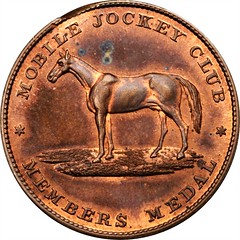
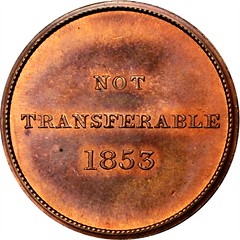
Alabama--Mobile.1853 Mobile Jockey Club Members Medal. Miller-Ala 3. Copper. 27.4 mm. MS-63 RB.
Boldly reflective in the fields which have strong violet and blue iridescence. Deep tan otherwise with considerable mint red remaining around all devices and through the legends. A small planchet imperfection is noted at the rim above the horse’s head, which is as made. Visually striking and popular.
To view the complete lot description, see:
Alabama--Mobile.1853 Mobile Jockey Club Members Medal. Miller-Ala 3. Copper. 27.4 mm.
(www.stacksbowers.com/BrowseAuctions/LotDetail/
tabid/227/AuctionID/6039/Lot/10097/Default.aspx)
1853 H.B. West’s Trained Dogs Advertising Card
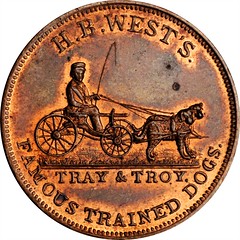
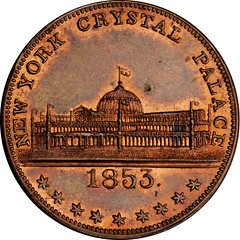
New York--New York. Lot of (3) 1853 H.B. West’s Trained Dogs Advertising Cards.
Included are: Miller-NY 948, copper, MS-63 BN, light olive brown with considerable red around the devices; Miller-NY 949, brass, AU-55, lustrous brass, with deeper patina on the high points; and Miller-NY 949A, silvered brass, AU-55, bright and lustrous, but with light verdigris. An attractive threesome of this merchant issue. The tokens were sold at the New York Crystal Palace, where H.B. Wests' dogs were among the amusements available to attendees of the fair.
To view the complete lot description, see:
New
York--New York. Lot of (3) 1853 H.B. West’s Trained Dogs Advertising Cards.
(www.stacksbowers.com/browseauctions/lotdetail.aspx?
AuctionID=6039&Lot=10098)
John F. Beazell Counterfeit Detector
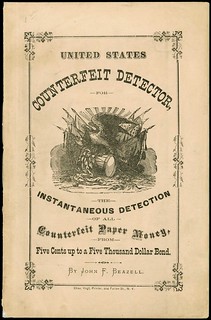
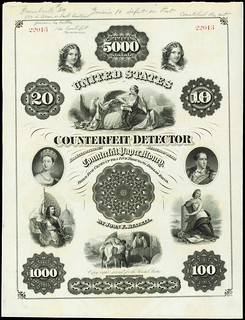
John F. Beazell United States Counterfeit Detector. 1867. Vignette Broadside by Continental Bank Note Co. and Original Book. Very Fine.
A significant and handsome pairing of security printing history pieces featuring superb Continental Bank Note Company vignettes engraved and printed to a uniface broadside, but with the original accompanying book by John F. Beazell. The book is much rarer than the large quarto detection broadside and first we have catalogued. The pair includes; 1) Intaglio printed and titled broadside which was once tipped into an original book. 220mm by 320mm. Full titles and imprint. Four vignettes, four portraits, and seven dies or counters. Numbered 22013. Choice Very Fine with pencil notations at the upper left. 2) 1867 John F. Beazell original book ‘’UNITED STATES COUNTERFEIT DETECTOR –THE INSTANTANEOUS DETECTION OF ALL COUNTERFEIT PAPER MONEY, FROM Five cents Up to Five Thousand Dollar Bond’’. Octavo. Tan paper with vignette of eagle and drum. 16pp. Excellent condition and evidence of its sheet previously removed lightly at the inside front cover. The Continental Bank Note vignettes rather charming and with a distinctive post-war style. A beautiful pair and very few complete pairs or books remain extant.
To view the complete lot description, see:
John F. Beazell United States Counterfeit Detector. 1867. Vignette Broadside
(www.stacksbowers.com/BrowseAuctions/LotDetail.aspx?
AuctionID=6039&Lot=2232&LotID=395880)
SELECTIONS FROM THE LYN KNIGHT PCDA 2014 SALE
Central American Republic 100 Pesos
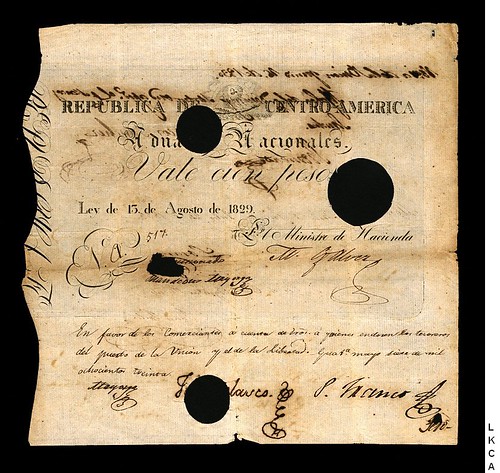
This magnificent piece is quite possibly the most important bank note of Central America discovered to date. It was used to pay fees at ports of Central America. Of the greatest historical significance; most likely unique. There is even disagreement about how it should be attributed; we created a new category of the Central American Republic! Few documents of any kind from the Central American Republic have survived.
This piece is of added significance as it features the Republic's arms, which irrefutably proves the provenance of the rayed hat counter-stamp on Honduras and Nicaraguan coins of 1823-25. A significant part of this note is hand written. Large size; three punch cancellations. Two hand signatures, including that of the Ministro de Hacienda; hand written notations on back. Ink erosion. Several slits; margin tears. A fantastic collector piece that ties together many different regions of Latin America; the centerpiece of any advanced collection.
To read the complete auction lot description, see:
Central American
Republic 100 pesos (www.lynknight.com/ShowAuctionDetails.Asp?auction_Id=239778)
Australia 10 Pounds ND (1949)
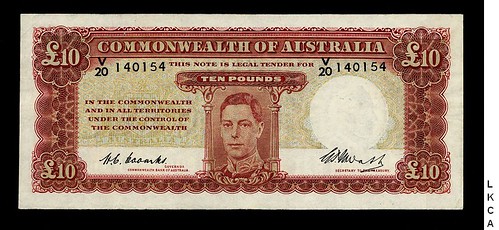
Highest issued denomination in the King George VI series; Coombs-Watt signatures. Pressed. We have offered this signature combination only a few times in the past twelve years.
To read the complete auction lot description, see:
Australia 10 Pounds ND
(1949) (www.lynknight.com/ShowAuctionDetails.Asp?Auction_ID=239678)
Bermuda 10 Shillings Essay ND (ca. 1947)

Uniface black and white essay; punch cancelled, without serial number. King George VI. "Approved 21.2.1951" at upper left and "submitted 15.2.1951" at upper right. PMG terms this "Ch. UNC 63 EPQ". Unusual in this form.
To read the complete auction lot description, see:
Bermuda 10 Shillings ND
(ca. 1947) (www.lynknight.com/ShowAuctionDetails.Asp?Auction_ID=232339)
1918 British West Africa 2 Shillings

Palm tree/Arabic script. WBG terms this "VF 20". Now extremely difficult.
To read the complete auction lot description, see:
British West Africa 2
Shillings 30.3.1918 (www.lynknight.com/ShowAuctionDetails.Asp?Auction_ID=235001)
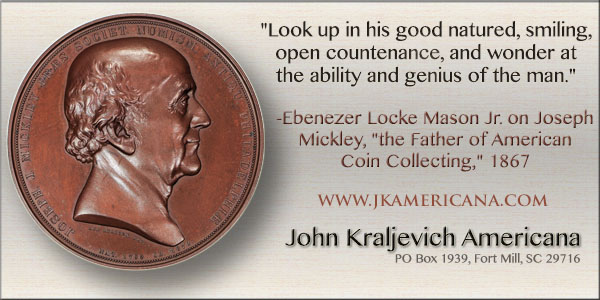
AUSTRALIAN ARTICLE HIGHLIGHTS BANKNOTE ERRORS
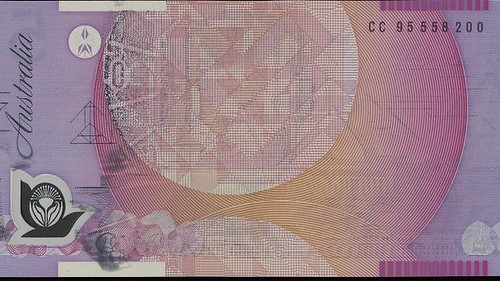
Even human error has a monetary value. Flawed stamps and coins have long been among the most desirable to collectors, and now mis-printed banknotes have their admirers.
As shown at Charles Leski's latest Coin, Banknotes, Stamps and Postal History auction (now held under the Mossgreen banner) an Australian banknote normally valued at $5 can be worth over $1000 if someone has accidentally stuffed it up.
This 1993 polymer note has a nominal value of $10 but because it is missing the intaglio printing phase on the front — the final stage in the printing process, that adds the fine details, such as writing or complex artwork – it's now worth much more. Adding to its value, there's no serial number on the reverse and the checker who spotted the error has added their ID number in felt pen.
Sold in "uncirculated" condition, it fetched $1220 IBP at the September 30 sale in Melbourne.
The question is, how do such obvious duds make it into the public domain?
Leski says that even in the polymer period the quality control of banknotes was initially done by humans, so the occasional misprint passed through the system and escaped into the real world. Among enthusiasts, the magnitude of the error is what determines value at auction. Errors can range from a missing serial number to, well, what you see here.
These are on the higher limits of the scale.
Condition is also important and these examples were obviously spotted early in their life-span and handed over to someone who cared. Twenty years later and, bingo, their face value has jumped by more than a thousand dollars in some cases.
Graham Shepherd is a pioneer in this specialist area.
A long-time collector and dealer in rare banknotes, he started to concentrate on error notes in 1988 and has since discovered that others share this eccentricity. He estimates there are a few hundred like-minded souls.
According to Shepherd the ones worth collecting are the bleedingly obvious, as in notes missing one colour or totally blank on one side. Examples of the latter also turn up on occasion.
Needless to say, if one appears in your spare change, keep it. What about counterfeit notes? Shepherd says these are also of interest to some collectors, despite the grey legality of owning them.
"I won't say whether I have any or not," he says, "but yes, they are quite collectable."
To read the complete article, see:
Note the errors, omissions and cash in (www.theage.com.au/money/investing/note-the-errors
-omissions-and-cash-in-20141010-1141ug.html)
ELEPHANT ON NEPAL 1,000-RUPEE NOTE QUESTIONED
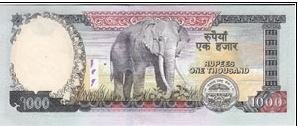 It is not known why the back side of bank notes here
bear images of animals, although Nepal Rastra Bank officials say it’s because of their neutral
characteristic. "If images of temples are used, they might trigger controversy because of
religious connotations. That may be the reason," a senior NRB official said on condition of
anonymity.
It is not known why the back side of bank notes here
bear images of animals, although Nepal Rastra Bank officials say it’s because of their neutral
characteristic. "If images of temples are used, they might trigger controversy because of
religious connotations. That may be the reason," a senior NRB official said on condition of
anonymity.
Whatever the reason, all pictures of animals printed on bank notes are said to be of animals found in Nepal — except for one, which has confused even wildlife experts. And that is the image of an elephant printed on the back side of the 1,000-rupee note, which, experts say, resembles the elephant found in Africa.
This ambiguity has prompted many to suspect whether the 1,000-rupee notes have long been bearing the picture of an African elephant rather than of those roaming the country’s forests.
No wonder, NRB, which issues bank notes, has started reviewing pictures of all animals printed on notes and is mulling their replacement with images of animals found in the country.
Bank notes of 1,000-rupee denomination were first issued in December 1969 — although the history of bank note circulation dates back to September 1945.
At that time, these 1,000-rupee notes contained the picture of a rural setting with Mount Annapurna in the backdrop.
Then in December 1974, the design was reviewed and the picture of an elephant with long tusks was used.
Since then, 1,000-rupee notes are being printed with the same picture of an elephant.
The picture of the elephant used in the note, according to ‘Notes and Coins of Nepal’— a book published to mark NRB’s Golden Jubilee — is that of an ‘Asian male elephant’.
But experts doubt it.
"The picture contains features of both Asian and African elephants," Narendra Pradhan, an elephant expert, told The Himalayan Times.
"For instance, the head appears to be that of an Asian elephant, as it contains two humps on the top part of the skull," he said. The top part of the head of the African elephant, on the other hand, is more round in shape.
But the similarity ends here.
"The appearance of the elephant in the picture, especially body size and ears, resembles those found in Africa," Pradhan added. African elephants are bigger and have larger ears, Pradhan said. "Also, the shoulder of the African elephant rises above the head, as in the picture."
However, a wildlife expert working for World Wildlife Fund Nepal, said it would not be wrong ‘to call that elephant in the picture Asian’. "Its ears are not as big as those of African elephants and the body resembles Asian elephants," the source said. But she quickly added: "I don’t think it’s a real life picture. It must be artwork."
NRB is not aware of the source of the image. "Many images were taken a long time ago. We don’t know who took them or from where they were extracted. But they are definitely not artwork," the NRB official said, adding, "We are planning to replace all images of animals with those found in Nepal."
If things go as planned, the 1,000-rupee note will soon contain a picture of twin baby elephants — along with their mother — born some time ago at Chitwan National Park, according to the NRB source.
To read the complete article, see:
Elephant image on 1‚000-rupee bank note confuses even wildlife experts -
(www.thehimalayantimes.com/fullNews.php?
headline=Elephant+image+on+1%E2%80%9A000-
rupee+bank+note+confuses+even+wildlife+experts&NewsID=430639)
BANK OF CANADA WOMEN'S TROUBLE CONTINUES
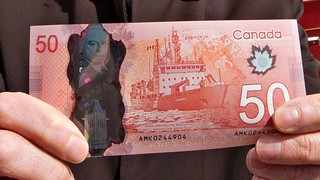 The Bank of Canada is in hot water again over bank note
design, just days after it revamped its policies to avoid more embarrassing controversies about the
country's currency.
The Bank of Canada is in hot water again over bank note
design, just days after it revamped its policies to avoid more embarrassing controversies about the
country's currency.
Former governor Mark Carney apologized to Canadians in August 2012 when it was revealed the bank had erased the Asian features of a female scientist featured on prototypes of the new $100 plastic banknote, after focus groups raised questions about her ethnicity.
A penitent Carney ordered a review of the design process for all future banknotes and Stephen Poloz, his successor, last week announced a new process as well as an online public consultation, ending Nov. 10.
But the announcement has only stirred up more trouble for the bank, as a group pressing to have images of famous women included in the next set of banknotes learned that their petitions and letters have apparently fallen on deaf ears.
The Bank of Canada's newly released design principles say nothing about putting women on the currency, vaguely referring only to "diversity."
"It's disappointing, it's insulting, it's discriminatory and it's offensive," said Merna Forster, a historian and author in Victoria who has been leading the public campaign.
"How many more surveys and public consultations will it take to convince the Bank of Canada to commit to including women on bank notes," she said in an interview. "This is not rocket science."
The current series of polymer banknotes feature no famous Canadian women, though the Queen's image is on all denominations. The previous series included images of the Famous Five, who fought for women's rights in Canada, and Therese Casgrain, a Quebec feminist. But they were all replaced on the new $50 note by an image of an icebreaker
To read the complete article, see:
Bank of Canada still not committed to women on currency, petition says
(www.cbc.ca/news/politics/bank-of-canada-still-not-committed-to-women-on-currency-petition-says-1.2795349)
THE BOOK BAZARRE
KERRY STOKES: AUSTRALIAN BUYER OF VICTORIA CROSS MEDALS
"Dasher" Wheatley was a tough working class lad who played football bravely — hence his nickname — and liked a laugh and a drink. "A crazy bastard — you could hit him with a hammer and not hurt him," one of his old army mates says.
Wheatley was fearless. The face that stares out of photographs oozes the nonchalant confidence of a bull terrier. His wife Edna was widowed at 26 by an act of suicidal bravery.
It happened in the Tra Bong Valley in Vietnam on 13 November 1965. Called on to retreat to safety, "Dasher" refused, staying with his wounded mate, Ron "Butch" Swanton.
A medic bandaged the dying Swanton and begged Wheatley to escape. Wheatley carried his mate to some trees and refused to abandon him.
The last thing the medic saw Wheatley do was to prime two grenades and wait, one in each hand, for certain death.
 Wheatley was awarded a posthumous Victoria Cross. For years, the medal went to school with the kids
on Anzac Days. But Edna had a dilemma. Would the piece of precious metal eventually be left to
George, as the eldest, or should it be sold to benefit them all?
Wheatley was awarded a posthumous Victoria Cross. For years, the medal went to school with the kids
on Anzac Days. But Edna had a dilemma. Would the piece of precious metal eventually be left to
George, as the eldest, or should it be sold to benefit them all?
Edna had been left worse than poor. Anti-war protesters had persecuted her as the wife of a "baby killer". They heckled her and daubed hate slogans in red paint on the fence of her house, west of Sydney. She moved down the coast to raise her kids in anonymity.
By 1993, money mattered more than having a medal in a drawer.
She put the medal up for auction. It was the first Australian VC for sale in years. She faced ugly accusations she was "selling out" her husband’s bravery.
The RSL led the chorus. Alarmed that a foreign collector might buy it, the league asked every Australian serviceman and woman to donate, a drive that raised some $60,000. It was then that Stokes offered to "top up" the price to keep the medal in Australia.
The medal went for $160,000. It was reported "a businessman" had donated the $100,000 to meet the price but his identity soon leaked.
 It was the start of Stokes’s interest in buying VCs. He would
later buy another six over several years, some for massive sums. He gave them all to the Australian
War Memorial.
It was the start of Stokes’s interest in buying VCs. He would
later buy another six over several years, some for massive sums. He gave them all to the Australian
War Memorial.
He doesn’t talk about the cost of individual medals. He says that each, having been earned by blood and bravery, is worth as much as another. The truth is he has spent millions on the medals – and on the memorial.
Stokes shrugs it off. "I’m lucky enough to be able to do what most Australians would do if they could," he says.
To read the complete article, see:
Kerry Stokes is the tycoon with a heart who collects Diggers’ medals — only to give them away
(www.heraldsun.com.au/news/kerry-stokes-is-the-tycoon-with-a-heart-who-collects-diggers-medals-only-to-give-them-away/story-fni0fiyv-1227094253814)
THE BOOK BAZARRE
MORE ON POP-UP COINS

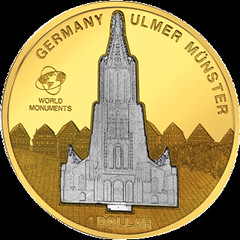
To answer the insert-pop-up question, here is an illustration of a Cook Islands item. Gold plated copper "coin", with a silver plated "pop up" feature.
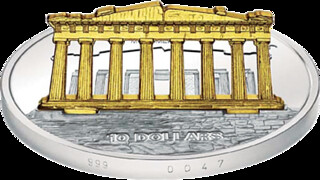 Two planchets, one as an irregular shape die cut out, with
a small rectangle at the bottom edge, which fits into a rectangular depression in the coin
base.
Two planchets, one as an irregular shape die cut out, with
a small rectangle at the bottom edge, which fits into a rectangular depression in the coin
base.
This is a specialty of the Mayer Mint (a private mint doing many NCLT issues)
To visit the Mayer Mint web site, see:
www.mayermint.com
To read the earlier E-Sylum article, see:
QUERY: THE COOK ISLANDS POP-UP COIN
(www.coinbooks.org/esylum_v17n42a19.html)
PAUL BOSCO RECALLS FAILED SLAB SALE ATTEMPT
At the outset, let me acknowledge that I can't hold a candle to Numismatist editor Barbara Gregory, when the subject is Toilets in Numismatics.
In 1975-76 I worked at Schulman Coin & Mint, under the late Gerry Bauman, who went on to better things at Manfra, Tordella and Brooks -- like the first sale of a coin for $1,000,000 (a Paquet $20).
Schulman had a store with a tall window at #40 on West 57th Street, one of the world's great shopping streets. In his wisdom, he bought a Lucite toilet seat with one or more silver dollars and a selection of fairly current coins and $1 bills. Gerry mounted this in the front window, with a price of $300 or so. As I am known for my everpresent dignity, this was much to my chagrin. It attracted considerable attention for perhaps a full year. I think Gerry may have eventually bought it at cost and given it as a gift, demonstrating the downside of friendship..
The closest we came to selling it was when a couple from Chile was very interested. This was shortly after Allende was overthrown, or, as I would have it, murdered. They were fine with the death of the "communist".
I learned a lot about myself that day. I found the couple politically reprehensible, but the toilet seat was aesthetically reprehensible. They deserved to be verbally savaged as murderous pigs, but they were also my best hope for getting rid of the damned thing in the window. I decided they were not as obscene as the crapper cover, and only then became aware of the shallow self-interest of my "situational ethics".
They had one reservation: Would it be of a size compatible with Chilean toilets? I suggested we take it out of the window so they could sit on it and measure it with their cheeks. Even then, I did not give up easily on a potential sale. And even cheekier, I told them Chile was a backwards country.
They were stunned, but then I explained that when you flush a toilet in the Southern Hemisphere, the water swirls in the opposite direction of the North American flush. I hastened to add that this did not affect the functionality of the unique and artistic status symbol under consideration for purchase. Alas, despite my best (but probably not my most absurd) efforts, they did not add to the miseries of their country by importing into it this ludicrosity in Lucite.
To read the earlier E-Sylum article, see:
COIN-FILLED LUCITE TOILET SEAT
(www.coinbooks.org/esylum_v17n39a33.html)

FEATURED WEB PAGE: MICRONATIONS
This week's Featured Web Page is ListOfMicronations.com, a compendium of information on micronations and their coinage.With several important qualifications, a micronation is any entity which purports to be or has the appearance of being a sovereign state but isn't.
Micronations are typically created and maintained by one person or family. Many exist solely on the internet, or in the imagination of their creators.
Some have a more corporeal existence, making ambit claims over, or occasionally even physically occupying defined geographical locations - albeit often tiny, remote or uninhabitable ones - and producing physical artefacts such as stamps, coins, banknotes, passports, medals and flags.
Micronations are generally viewed as ephemeral, eccentric and somewhat amusing by most external observers.
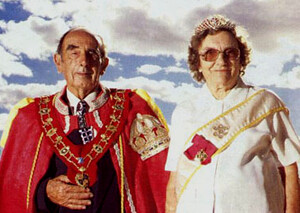
www.listofmicronations.com
